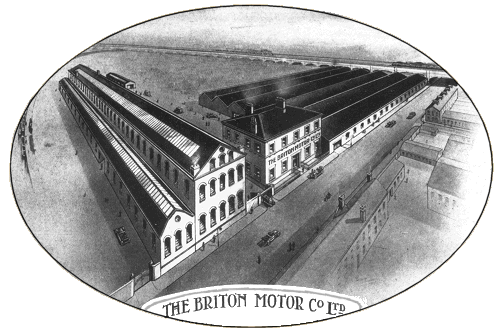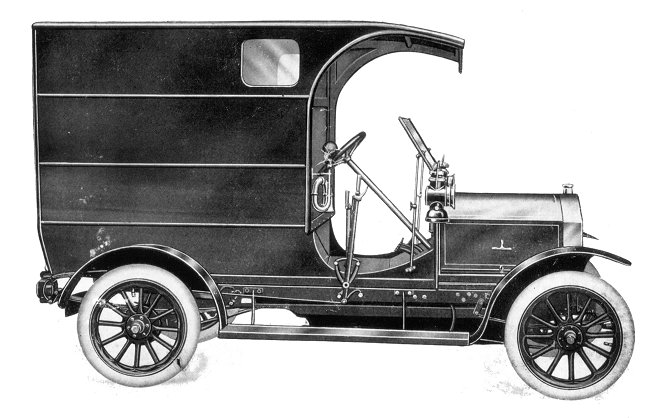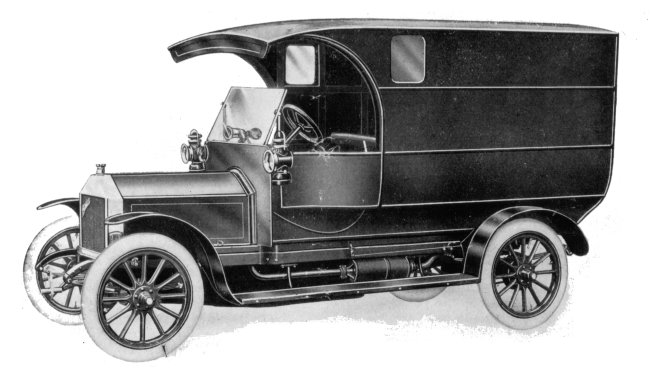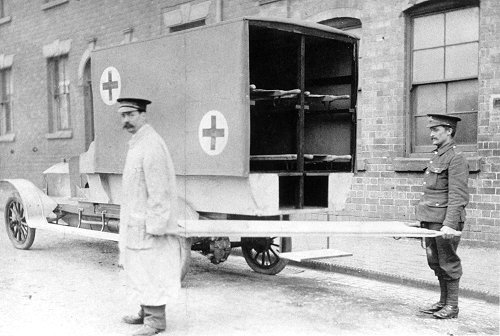| Briton
Background
In 1905 the Star Cycle Company of Wolverhampton began to produce a
low-cost range of cars, initially under the ‘Starling’ name, adding
a ‘Stuart’ model a year later. In 1909 the manufacture of ‘Starling’
and ‘Stuart’ cars ceased, and were replaced by Briton cars,
manufactured by the Briton Car Company under the direction of Edward
Lisle Junior, the son of Star's founder. The new company had a
capital of £50,000.
Briton started life in the company’s Stewart Street Works, but
within a few years moved to a larger, purpose built factory in
Lower Walsall Street, Wolverhampton. In 1912 the Briton Motor
Company (1912) limited was formed and six acres of land were
purchased between Lower Walsall Street and Horseley Fields on which
to build the new factory. The site had previously been occupied by
the northern half of Shrubbery Iron Works. The company moved to the
site in 1913 and introduced the 10/12hp. and the 14/16hp. cars, and
light commercial vehicles. |

Lower Walsall Street Works.
|
Briton
Light Commercial Vehicles On Sale In 1914

5 cwt.
10-12 hp. 2-cylinder light delivery van.
Specification: |
|
Engine: |
10 hp., 2-cylinder, bore 98 mm., stroke 120 mm.,
R.A.C. rating. 11.9 hp. All valves on one side,
interchangeable. Nominal speed 1,000 r.p.m. |
|
Clutch: |
Leather covered cone type. |
|
Ignition: |
H.T. magneto, fixed. |
|
Carburettor: |
Latest type, regulated by hand and foot. |
|
Gearbox: |
Gate change, latest and improved type; all shafts
running on self-contained journal bearings. 3 forward
speeds, and one reverse. Direct drive on third speed. |
|
Water Circulation: |
Thermo syphon, in conjunction with a large radiator,
and a fan. |
|
Frame: |
Specially designed pressed, and strengthened, deep
section steel frame. |
|
Suspension: |
Special heavy springs, made of the best quality
spring steel, ¾ elliptic at the rear. |
|
Transmission: |
By Cardan shaft, with very effective universal
joints at the gearbox and back axle ends, with provision
for efficient lubrication. |
|
Brakes: |
A very powerful foot-brake is fitted, and also two
effective brakes on the road wheels. |
|
Wheels: |
Artillery, running on self-contained journal
bearings. |
|
Tyres: |
Dunlop, heavy plain 700x85 mm. |
|
Dimensions: |
Wheelbase, 7' 10"; track, 4' 3"; length overall, 11'
6"; width overall, 5' 4";
weight around 15 cwt. |
| |
Complete with 3 lamps, horn, tyre pump, and all
tools. |
|
Price: |
155 guineas. |

7 cwt. 10-12 hp.
4-cylinder light delivery van.
| Engine: |
10 hp., 4-cylinder, bore 68 mm., stroke 120
mm., R.A.C. rating. 11.3 hp. Cylinders cast in pairs, all
valves on one side, interchangeable. Nominal speed 1,000
r.p.m. |
| Clutch:
|
Leather covered cone type. |
| Ignition:
|
H.T. magneto, fixed. |
| Carburettor: |
Zenith, regulated by hand and foot. |
| Gearbox: |
Gate change, latest and improved type; all
shafts running on self-contained journal bearings. 3 forward
speeds, and one reverse. Direct drive on third speed. |
| Water Circulation: |
Thermo syphon, in conjunction with a large
radiator, and a fan. |
| Frame:
|
Specially designed pressed, and
strengthened, deep section steel frame. |
| Suspension:
|
Special heavy springs, made of the best
quality spring steel, ¾ elliptic at the rear. Lubricators
fitted to shackle pins, special heavy type. |
| Transmission: |
By Cardan shaft, with very effective
universal joints at the gearbox and back axle ends, with
provision for efficient lubrication. |
| Brakes: |
A very powerful foot-brake is fitted, and
also two effective brakes on the road wheels. |
| Wheels: |
Artillery, running on self-contained journal
bearings. |
| Tyres: |
Dunlop, heavy plain 700x85 mm. |
| Dimensions:
|
Wheelbase, 8' 6"; track, 4' 3"; length
overall, 12'; width overall, 5' 4"; weight around 17 cwt. |
| |
Complete with 3 lamps, horn, tyre pump, and
all tools. |
| Price:
|
185 guineas. |

15 cwt. 14-16 hp.
4-cylinder light delivery van.
|
Engine: |
14 hp., 4-cylinder, bore 80 mm., stroke 120 mm., R.A.C.
rating. 15.9 hp. Cylinders cast in pairs, all valves on one
side, interchangeable. Nominal speed 1,000 r.p.m. |
|
Clutch: |
Leather covered cone type. |
|
Ignition: |
H.T. magneto, fixed. |
|
Carburettor: |
Zenith, regulated by hand and foot. |
|
Gearbox: |
Gate change, latest and improved type; all shafts
running on self-contained journal bearings. 3 forward
speeds, and one reverse. Direct drive on third speed. |
| Water
Circulation: |
Thermo syphon, in conjunction with a large radiator, and
a fan. |
| Frame: |
Specially designed pressed, and strengthened, deep
section steel frame. |
|
Suspension: |
Special heavy springs, made of the best quality spring
steel, ¾ elliptic at the rear. Lubricators fitted to shackle
pins, special heavy type. |
|
Transmission: |
By Cardan shaft, with very effective universal joints at
the gearbox and back axle ends, with provision for efficient
lubrication. |
|
Brakes: |
A very powerful foot-brake is fitted, and also two
effective brakes on the road wheels. |
|
Wheels: |
Artillery, running on self-contained journal bearings. |
| Tyres:
|
Dunlop, heavy plain 760x90 mm. |
|
Dimensions: |
Wheelbase, 8' 10"; track, 4' 3"; length overall, 12' 6";
width overall, 5' 4"; weight around 18 cwt. |
| |
Complete with 3 lamps, horn, tyre pump, and all tools. |
| Price:
|
220 guineas. |
World War One and Later
Car production continued throughout much of the war, along with war
work, including the machining of shell cases. Briton also
became the UK agent for the American Scripps-Booth light car, but the
venture failed.
In 1917 and 1918 only the 5 cwt., 7 cwt., and 15 cwt. light delivery vans,
and ambulances were produced.
The company also made a 50cwt commercial vehicle powered by a Dorman
engine. Only five were built. |

An advert from 1916.
| The 50 cwt. chassis were
as follows: |
Dorman
engine type |
Engine
number |
purchase
date |
Customer |
| 4JJ |
unknown |
1916 |
unknown |
| 4JO |
2413 |
June 1917 |
Foale & Brook, Ironfounders, Slaithwaite, Huddersfield. |
| 4JO |
2568 |
May 1917 |
William Blythe & Company, Church Cross, Lancashire. |
| 4JJ |
3337 |
1920 |
A. P. Phillips, Market Drayton, Shropshire. |
| 4JO |
3842 |
March 1921 |
S. R. Turner, Bristol Street, Birmingham. |
| |
|
|
|

Briton 14 hp., 4-cylinder, 15 cwt.,
prototype Red Cross Ambulance outside the Briton factory.
Courtesy of the late Charles Weight. |
| Unfortunately Briton found itself in trouble with the government
because it had failed to meet all of its contractual obligations during
the war. As a result the government demanded financial
compensation, which resulted in
a call for shares of £50,000. Production resumed in 1919 with the launch of the 10/12hp. car
which sold for 420 guineas. The company raised £50,000 from an issue of shares,
and three
new models were designed including a Chapuius Dornier engined sports
car, but never went into production.
During 1920 a total of 170 cars were built, but by this time the larger car
manufacturers such as Austin and Morris had adopted mass production
techniques and were selling their cars for as little as £100.
Briton could not compete in this market and was in deep
financial trouble. In December 1920 the Midland Bank took
£50,000 of debenture stock, and during 1921 only 65 cars were built. In December of
that year the bank appointed receivers; Harold Jeddon and Edgar W.
Woolley. A month later a liquidator was appointed, the value of the
company being assessed at £30,500. On 3rd October, 1922
estate agents Page and Sons sold the factory to A. J. Stevens & Company (1914) Limited for £7,000.
The car side of the business was sold to Charles A. Weight,
who purchased the machinery, and stock of spare parts. They
were moved to his factory at Chillington Fields,
Wolverhampton, where a number of cars were built. |
|